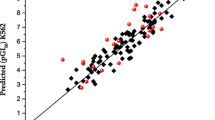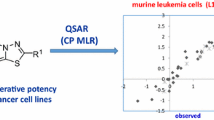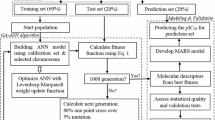Abstract
Quantitative structure–activity relationship modeling of 4-anilinofuro[2,3-b]quinoline derivatives have been subjected in the current study utilizing theoretical molecular descriptors calculated solely from the structures of chemical compounds. This study explored the influences of electrostatic, topological, constitutional, geometrical, and physicochemical descriptors toward antimitotic activities of these compounds. Stepwise forward–backward-based feature selection coupled with partial least squares was used as a chemometric tool for QSAR modeling. The training models were properly validated and focused regarding the different structural aspects necessary for designing potent compounds in these series. Further in vitro absorption and distribution were studied using PreADMET algorithm for these series of compounds to predict important structural requirements. More hydrophilic of these congeneric compounds potentiate antimitotic activity. O-substituted dimethyl aminoalkyl oxime moiety makes the compound more hydrophilic and free for interaction with the mitotic spindle. Predictive absorption and distribution study through Caco-2 cell permeability and plasma protein binding (%) help to design more active antimitotic compounds in this congeners.


Similar content being viewed by others
References
Chen IL, Chen YL, Tzeng CC, Chen IS (2002) Synthesis and cytotoxic evaluation of some 4-anilinofuro[2,3-b]quinoline derivatives. Helv Chim Acta 85:2214–2221
Chen YL, Lin HC, Yang CN, Lu PJ, Tzeng CC (2008) Synthesis and antiproliferative evaluation of certain 4-anilino-7-methoxyfuro[2,3-b]quinoline and 4-anilino-6-methoxyfuro[2,3-b]quinolone derivatives. Part 5. Chem Biodivers 4:267–278
Chen YW, Chen YL, Tseng CH, Liang CC, Yang CN, Yao YC, Lu PJ, Tzeng CC (2011) Discovery of 4-Anilinofuro[2,3-b]quinoline derivatives as selective and orally active compounds against non-small-cell lung cancers. J Med Chem 54:4446–4461
Halgren TA (1996) Merck Molecular Force Field. III. Molecular Geometries and Vibrational Frequencies. J Comput Chem 17:553–586
Hoskuldsson A (1988) PLS regression methods. J Chemometr 2:211–228
Hubatsch I, Ragnarsson EGE, Artursson P (2007) Determination of drug permeability and prediction of drug absorption in Caco-2 monolayers. Nat Protoc 2:2111–2119 http://www.preadmet.brdrc.org/
Jordan MA, Wilson L (2004) Microtubules as a target for anticancer drugs. Nat Rev Cancer 4:253–265
Kier LB (1989) Indices of molecular shape from chemical graphs. In: Rouvray DH (ed) Computational chemical graph. Nova, New York
Kier LB, Hall LH (1981) Derivation and significance of valence molecular connectivity. J Pharm Sci 70:583–589
Kier LB, Hall LH (1986) Molecular connectivity in structure-activity analysis. Research studies, Letchworth
Kier LB, Hall LH (1991) The Molecular connectivity Chi indices and Kappa shape indices in structure-property modeling. In: Boyd D, Lipkowitz K (eds) Reviews of computational chemistry. VCH Publishers Inc., Weinheim, pp 367–422
Lee SK, Lee IH, Kim J, Chang GS, Chung JE, No KT (2003) The PreADME Approach: Web-based program for rapid prediction of physico-chemical, drug absorption and druglike properties, EuroQSAR 2002 designing drugs and crop protectants: processes, problems and solutions. Blackwell, Malden, pp 418–420
Molecular Design Suite 3.5, VLife Technologies, Pune, India.www.vlifesciences.com
Nandi S, Bagchi MC (2009) QSAR of aminopyrido[2,3-d]pyrimidin-7-yl derivatives: anticancer drug design by computed descriptors. J Enzyme Inhib Med Chem 24:937–948
Nandi S, Bagchi MC (2010) 3D-QSAR and molecular docking studies of 4-anilinoquinazoline derivatives: a rational approach to anticancer drug design. Mol Divers 14:27–38
Nandi S, Bagchi MC (2011a) Activity prediction of some non tested anticancer compounds using GA based PLS regression models. Chem Biol Drug Des 78:587–595
Nandi S, Bagchi MC (2011b) In silico design of potent EGFR kinase inhibitors using combinatorial libraries. Mol Simul 37:196–209
Randić M (1975) Characterization of molecular branching. J Am Chem Soc 97:6609–6615
Roy PP, Roy K (2008) On some aspects of variable selection for partial least squares regression models. QSAR Comb Sci 27:302–313
Roy PP, Roy K (2009) Comparative chemometric modeling of cytochrome 3A4 inhibitory activity of structurally diverse compounds using stepwise MLR, FA-MLR, PLS, GFA, G/PLS and ANN techniques. Eur J Med Chem 44:2913–2922
Roy K, Chakraborty P, Mitra I, Ojha PK, Kar S, Das RN (2013) Some Case Studies on Application of ‘‘r 2m ′’ Metrics for Judging Quality of Quantitative Structure–Activity Relationship Predictions: emphasis on Scaling of Response Data. J Comput Chem 34:1071–1082
Stanslas J, Hagan DJ, Ellis MJ, Turner C, Carmichael J, Ward W, Hammonds TR, Stevens MFG (2000) Antitumor polycyclic acridines. 7. Synthesis and biological properties of DNA affinic tetra- and pentacyclic acridines. J Med Chem 43:1563–1572
Su TL, Chou TC, Kim JY, Huang JT, Ciszewska G, Ren WY, Otter GM, Sirotnak FM, Watanabe KA (1995) 9-Substituted acridine derivatives with long half-life and potent antitumor activity: synthesis and structure_activity relationships. J Med Chem 38:3226–3235
Acknowledgments
Authors are sincerely thankful to their Institutions for providing necessary facilities to complete this study. SN tenders a deep sense of gratitude to his Post-Doc supervisor, Dr. Marjana Novič, National Institute of Chemistry, Ljubljana, Slovenia for the constructive discussion in this text. MCB acknowledges the Council of Scientific and Industrial Research, New Delhi, India for the Grant of a CSIR Emeritus Scientist award to him.
Author information
Authors and Affiliations
Corresponding author
Electronic supplementary material
Below is the link to the electronic supplementary material.
Rights and permissions
About this article
Cite this article
Nandi, S., Bagchi, M.C. QSAR modeling of 4-anilinofuro[2,3-b]quinolines: an approach to anticancer drug design. Med Chem Res 23, 1672–1682 (2014). https://doi.org/10.1007/s00044-013-0759-1
Received:
Accepted:
Published:
Issue Date:
DOI: https://doi.org/10.1007/s00044-013-0759-1




